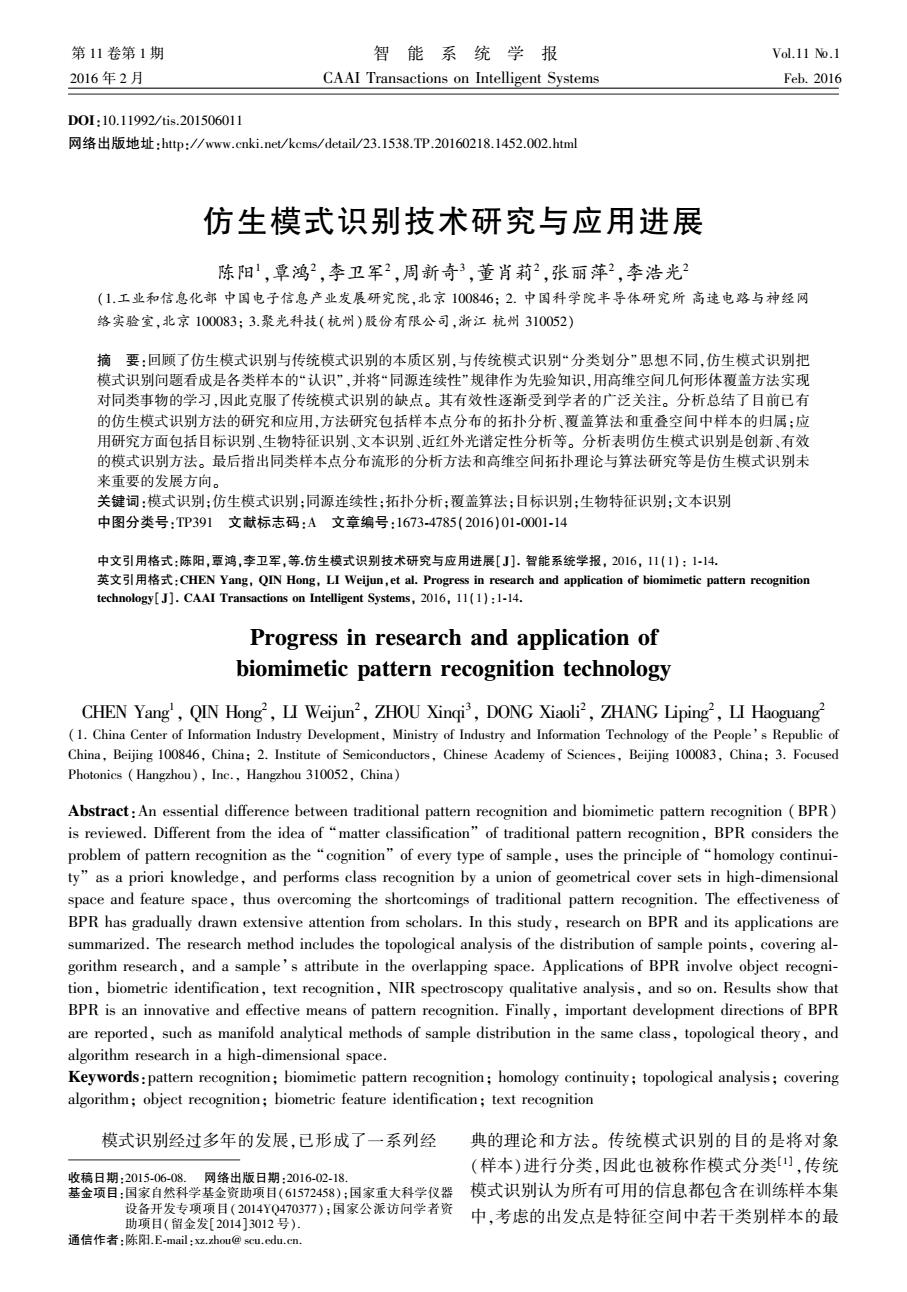正在加载图片...

第11卷第1期 智能系统学报 Vol.11 No.1 2016年2月 CAAI Transactions on Intelligent Systems Feb.2016 D0I:10.11992/is.201506011 网络出版地址:http:/www.cnki.net/kcms/detail/23.1538.TP.20160218.1452.002.html 仿生模式识别技术研究与应用进展 陈阳,覃鸿2,李卫军2,周新奇3,董肖莉2,张丽萍2,李浩光2 (1.工业和信息化部中国电子信息产业发展研究院,北京100846:2.中国科学院半导体研究所高速电路与神经网 络实验室,北京100083:3.聚光科技(杭州)股份有限公司,浙江杭州310052)】 摘要:回顾了仿生模式识别与传统模式识别的本质区别,与传统模式识别“分类划分”思想不同,仿生模式识别把 模式识别问题看成是各类样本的“认识”,并将“同源连续性”规律作为先验知识,用高维空间几何形体覆盖方法实现 对同类事物的学习,因此克服了传统模式识别的缺点。其有效性逐渐受到学者的广泛关注。分析总结了目前已有 的仿生模式识别方法的研究和应用,方法研究包括样本点分布的拓扑分析、覆盖算法和重叠空间中样本的归属:应 用研究方面包括目标识别、生物特征识别、文本识别、近红外光谱定性分析等。分析表明仿生模式识别是创新、有效 的模式识别方法。最后指出同类样本点分布流形的分析方法和高维空间拓扑理论与算法研究等是仿生模式识别未 来重要的发展方向。 关键词:模式识别:仿生模式识别:同源连续性:拓扑分析:覆盖算法:目标识别:生物特征识别;文本识别 中图分类号:TP391文献标志码:A文章编号:1673-4785(2016)01-0001-14 中文引用格式:陈阳,覃鸿,李卫军,等.仿生模式识别技术研究与应用进展[J].智能系统学报,2016,11(1):1-14. 英文引用格式:CHEN Yang,QIN Hong,LI Weijun,etal.Progress in research and application of biomimetic pattern recognition technology[J].CAAI Transactions on Intelligent Systems,2016,11(1):1-14. Progress in research and application of biomimetic pattern recognition technology CHEN Yang',QIN Hong,LI Weijun2,ZHOU Xinqi,DONG Xiaoli2,ZHANG Liping,LI Haoguang? (1.China Center of Information Industry Development,Ministry of Industry and Information Technology of the People's Republic of China,Beijing 100846,China;2.Institute of Semiconductors,Chinese Academy of Sciences,Beijing 100083,China;3.Focused Photonics Hangzhou),Inc.,Hangzhou 310052,China) Abstract:An essential difference between traditional pattern recognition and biomimetic pattern recognition(BPR) is reviewed.Different from the idea of "matter classification"of traditional pattern recognition,BPR considers the problem of pattern recognition as the "cognition"of every type of sample,uses the principle of"homology continui- ty"as a priori knowledge,and performs class recognition by a union of geometrical cover sets in high-dimensional space and feature space,thus overcoming the shortcomings of traditional pattern recognition.The effectiveness of BPR has gradually drawn extensive attention from scholars.In this study,research on BPR and its applications are summarized.The research method includes the topological analysis of the distribution of sample points,covering al- gorithm research,and a sample's attribute in the overlapping space.Applications of BPR involve object recogni- tion,biometric identification,text recognition,NIR spectroscopy qualitative analysis,and so on.Results show that BPR is an innovative and effective means of pattern recognition.Finally,important development directions of BPR are reported,such as manifold analytical methods of sample distribution in the same class,topological theory,and algorithm research in a high-dimensional space. Keywords:pattern recognition;biomimetic pattern recognition;homology continuity;topological analysis;covering algorithm;object recognition;biometric feature identification;text recognition 模式识别经过多年的发展,已形成了一系列经 典的理论和方法。传统模式识别的目的是将对象 (样本)进行分类,因此也被称作模式分类山,传统 收稿日期:2015-06-08.网络出版日期:2016-02-18. 基金项目:国家自然科学基金资助项目(61572458):国家重大科学仪器 模式识别认为所有可用的信息都包含在训练样本集 设备开发专项项目(2014YQ470377):国家公派访问学者资 助项目(留金发[2014]3012号). 中,考虑的出发点是特征空间中若干类别样本的最 通信作者:陈阳.E-mail:z.zhou@scu.cdu.cn第 11 卷第 1 期 智 能 系 统 学 报 Vol.11 №.1 2016 年 2 月 CAAI Transactions on Intelligent Systems Feb. 2016 DOI:10.11992 / tis.201506011 网络出版地址:http: / / www.cnki.net / kcms/ detail / 23.1538.TP.20160218.1452.002.html 仿生模式识别技术研究与应用进展 陈阳1 ,覃鸿2 ,李卫军2 ,周新奇3 ,董肖莉2 ,张丽萍2 ,李浩光2 (1.工业和信息化部 中国电子信息产业发展研究院,北京 100846; 2. 中国科学院半导体研究所 高速电路与神经网 络实验室,北京 100083; 3.聚光科技(杭州)股份有限公司,浙江 杭州 310052) 摘 要:回顾了仿生模式识别与传统模式识别的本质区别,与传统模式识别“分类划分”思想不同,仿生模式识别把 模式识别问题看成是各类样本的“认识”,并将“同源连续性”规律作为先验知识,用高维空间几何形体覆盖方法实现 对同类事物的学习,因此克服了传统模式识别的缺点。 其有效性逐渐受到学者的广泛关注。 分析总结了目前已有 的仿生模式识别方法的研究和应用,方法研究包括样本点分布的拓扑分析、覆盖算法和重叠空间中样本的归属;应 用研究方面包括目标识别、生物特征识别、文本识别、近红外光谱定性分析等。 分析表明仿生模式识别是创新、有效 的模式识别方法。 最后指出同类样本点分布流形的分析方法和高维空间拓扑理论与算法研究等是仿生模式识别未 来重要的发展方向。 关键词:模式识别;仿生模式识别;同源连续性;拓扑分析;覆盖算法;目标识别;生物特征识别;文本识别 中图分类号:TP391 文献标志码:A 文章编号:1673⁃4785(2016)01⁃0001⁃14 中文引用格式:陈阳,覃鸿,李卫军,等.仿生模式识别技术研究与应用进展[J]. 智能系统学报, 2016, 11(1): 1⁃14. 英文引用格式:CHEN Yang, QIN Hong, LI Weijun,et al. Progress in research and application of biomimetic pattern recognition technology[J]. CAAI Transactions on Intelligent Systems, 2016, 11(1):1⁃14. Progress in research and application of biomimetic pattern recognition technology CHEN Yang 1 , QIN Hong 2 , LI Weijun 2 , ZHOU Xinqi 3 , DONG Xiaoli 2 , ZHANG Liping 2 , LI Haoguang 2 (1. China Center of Information Industry Development, Ministry of Industry and Information Technology of the People’ s Republic of China, Beijing 100846, China; 2. Institute of Semiconductors, Chinese Academy of Sciences, Beijing 100083, China; 3. Focused Photonics (Hangzhou), Inc., Hangzhou 310052, China) Abstract:An essential difference between traditional pattern recognition and biomimetic pattern recognition (BPR) is reviewed. Different from the idea of “matter classification” of traditional pattern recognition, BPR considers the problem of pattern recognition as the “cognition” of every type of sample, uses the principle of “homology continui⁃ ty” as a priori knowledge, and performs class recognition by a union of geometrical cover sets in high⁃dimensional space and feature space, thus overcoming the shortcomings of traditional pattern recognition. The effectiveness of BPR has gradually drawn extensive attention from scholars. In this study, research on BPR and its applications are summarized. The research method includes the topological analysis of the distribution of sample points, covering al⁃ gorithm research, and a sample’ s attribute in the overlapping space. Applications of BPR involve object recogni⁃ tion, biometric identification, text recognition, NIR spectroscopy qualitative analysis, and so on. Results show that BPR is an innovative and effective means of pattern recognition. Finally, important development directions of BPR are reported, such as manifold analytical methods of sample distribution in the same class, topological theory, and algorithm research in a high⁃dimensional space. Keywords:pattern recognition; biomimetic pattern recognition; homology continuity; topological analysis; covering algorithm; object recognition; biometric feature identification; text recognition 收稿日期:2015⁃06⁃08. 网络出版日期:2016⁃02⁃18. 基金项目:国家自然科学基金资助项目(61572458);国家重大科学仪器 设备开发专项项目( 2014YQ470377);国家公派访问学者资 助项目(留金发[2014]3012 号). 通信作者:陈阳.E⁃mail:xz.zhou@ scu.edu.cn. 模式识别经过多年的发展,已形成了一系列经 典的理论和方法。 传统模式识别的目的是将对象 (样本)进行分类,因此也被称作模式分类[1] ,传统 模式识别认为所有可用的信息都包含在训练样本集 中,考虑的出发点是特征空间中若干类别样本的最